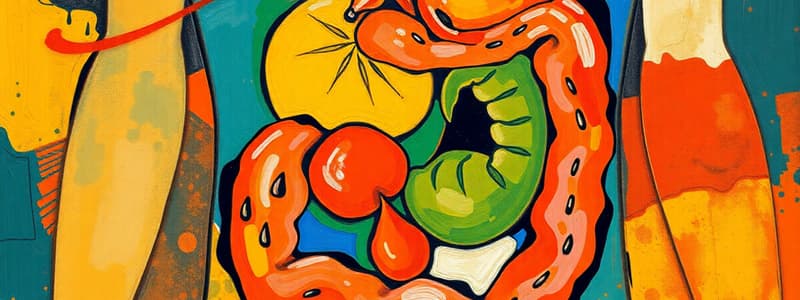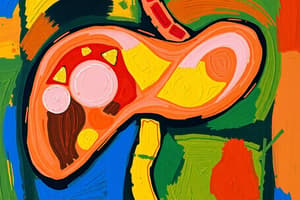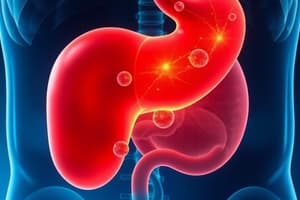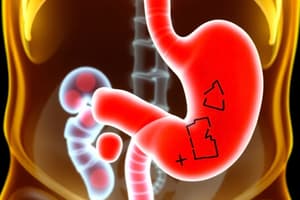Podcast
Questions and Answers
Which of the following physiological processes is MOST likely to contribute to the formation of cholesterol gallstones?
Which of the following physiological processes is MOST likely to contribute to the formation of cholesterol gallstones?
- Decreased cholesterol synthesis in the liver, resulting in lower bile saturation.
- Reduced bile secretion leading to increased cholesterol saturation. (correct)
- Increased frequency of gallbladder emptying, preventing bile stasis.
- Increased bile acid synthesis leading to enhanced cholesterol solubility.
A patient with a spinal cord injury is at risk for developing cholesterol gallstones due to which of the following mechanisms?
A patient with a spinal cord injury is at risk for developing cholesterol gallstones due to which of the following mechanisms?
- Decreased gallbladder motility leading to bile stasis. (correct)
- Increased physical activity causing increased cholesterol production.
- Frequent episodes of diarrhea leading to bile acid malabsorption.
- Increased vagal tone stimulating excessive bile secretion.
Which clinical manifestation would MOST strongly suggest a diagnosis of acute cholecystitis rather than chronic cholecystitis?
Which clinical manifestation would MOST strongly suggest a diagnosis of acute cholecystitis rather than chronic cholecystitis?
- Severe right upper quadrant pain accompanied by fever and leukocytosis. (correct)
- Asymptomatic presentation detected during routine abdominal imaging.
- Mild, intermittent discomfort in the right upper quadrant after fatty meals.
- Gradual onset of jaundice with mild elevation of liver enzymes.
A patient is diagnosed with acute cholecystitis. Which dietary modification is MOST appropriate for the initial management of this condition?
A patient is diagnosed with acute cholecystitis. Which dietary modification is MOST appropriate for the initial management of this condition?
Following a cholecystectomy, a patient reports continued abdominal pain and bloating after consuming a high-fat meal. What is the MOST appropriate instruction for this patient?
Following a cholecystectomy, a patient reports continued abdominal pain and bloating after consuming a high-fat meal. What is the MOST appropriate instruction for this patient?
A patient with advanced liver disease develops portal hypertension. Which clinical manifestation is a direct result of this condition?
A patient with advanced liver disease develops portal hypertension. Which clinical manifestation is a direct result of this condition?
A patient with liver failure is prescribed lactulose. What laboratory value should be monitored to assess the effectiveness of this medication?
A patient with liver failure is prescribed lactulose. What laboratory value should be monitored to assess the effectiveness of this medication?
A patient is diagnosed with Hepatitis A. Which preventative measure is MOST effective in preventing the spread of this infection?
A patient is diagnosed with Hepatitis A. Which preventative measure is MOST effective in preventing the spread of this infection?
A patient tests positive for Hepatitis B surface antigen (HBsAg) and Hepatitis B e antigen (HBeAg). What do these findings indicate about the patient's condition?
A patient tests positive for Hepatitis B surface antigen (HBsAg) and Hepatitis B e antigen (HBeAg). What do these findings indicate about the patient's condition?
A patient with Hepatitis C is prescribed antiviral treatment. What is the MOST important nursing education point regarding this treatment?
A patient with Hepatitis C is prescribed antiviral treatment. What is the MOST important nursing education point regarding this treatment?
A patient with non-alcoholic steatohepatitis (NASH) is discussing lifestyle modifications with the nurse. Which recommendation is MOST appropriate for managing this condition?
A patient with non-alcoholic steatohepatitis (NASH) is discussing lifestyle modifications with the nurse. Which recommendation is MOST appropriate for managing this condition?
A patient with alcoholic hepatitis is prescribed prednisolone. What is the primary goal of this medication in the treatment of this condition?
A patient with alcoholic hepatitis is prescribed prednisolone. What is the primary goal of this medication in the treatment of this condition?
Calcitonin is secreted by the thyroid gland and primarily affects calcium levels in the body by which mechanism?
Calcitonin is secreted by the thyroid gland and primarily affects calcium levels in the body by which mechanism?
Which medication is MOST likely to interfere with thyroid hormone level testing and potentially alter the results?
Which medication is MOST likely to interfere with thyroid hormone level testing and potentially alter the results?
Following a thyroidectomy, a patient develops muscle spasms during a blood pressure check. What immediate intervention is MOST appropriate?
Following a thyroidectomy, a patient develops muscle spasms during a blood pressure check. What immediate intervention is MOST appropriate?
A patient with hyperparathyroidism is MOST likely to exhibit which clinical manifestation?
A patient with hyperparathyroidism is MOST likely to exhibit which clinical manifestation?
A patient with hypothyroidism is started on levothyroxine. What instruction regarding the medication is MOST important for the nurse to provide?
A patient with hypothyroidism is started on levothyroxine. What instruction regarding the medication is MOST important for the nurse to provide?
Which clinical manifestation is MOST indicative of a thyroid storm in a patient with hyperthyroidism?
Which clinical manifestation is MOST indicative of a thyroid storm in a patient with hyperthyroidism?
A patient is receiving radioactive iodine for hyperthyroidism. What potential sign indicates a worsening of hyperthyroidism and requires immediate attention?
A patient is receiving radioactive iodine for hyperthyroidism. What potential sign indicates a worsening of hyperthyroidism and requires immediate attention?
A patient with Addison's disease is being discharged home. What dietary modification is MOST important for the nurse to emphasize?
A patient with Addison's disease is being discharged home. What dietary modification is MOST important for the nurse to emphasize?
What diagnostic test is MOST useful in differentiating between primary and secondary Cushing's disease?
What diagnostic test is MOST useful in differentiating between primary and secondary Cushing's disease?
A patient with Systemic Lupus Erythematosus (SLE) reports chest pain with breathing and movement. What potential complication should the nurse suspect?
A patient with Systemic Lupus Erythematosus (SLE) reports chest pain with breathing and movement. What potential complication should the nurse suspect?
Which clinical manifestation is MOST characteristic of rheumatoid arthritis?
Which clinical manifestation is MOST characteristic of rheumatoid arthritis?
A patient with scleroderma is experiencing esophageal dysfunction. Which intervention is MOST appropriate to address this issue?
A patient with scleroderma is experiencing esophageal dysfunction. Which intervention is MOST appropriate to address this issue?
A patient has a positive Mantoux skin test. What type of hypersensitivity reaction does this indicate?
A patient has a positive Mantoux skin test. What type of hypersensitivity reaction does this indicate?
A patient with HIV develops Pneumocystis jirovecii pneumonia. Which clinical manifestation is MOST indicative of this infection?
A patient with HIV develops Pneumocystis jirovecii pneumonia. Which clinical manifestation is MOST indicative of this infection?
A healthcare worker is exposed to HIV through a needlestick injury. What factor increases the risk of HIV infection following this exposure?
A healthcare worker is exposed to HIV through a needlestick injury. What factor increases the risk of HIV infection following this exposure?
A patient with HIV-associated wasting syndrome is experiencing significant weight loss. What intervention should the nurse prioritize?
A patient with HIV-associated wasting syndrome is experiencing significant weight loss. What intervention should the nurse prioritize?
A patient with HIV is concerned about preventing opportunistic infections. Which educational point is MOST important for the nurse to emphasize?
A patient with HIV is concerned about preventing opportunistic infections. Which educational point is MOST important for the nurse to emphasize?
A patient with Chronic Myeloid Leukemia (CML) is prescribed a tyrosine kinase inhibitor. What is the MOST important teaching point about this medication?
A patient with Chronic Myeloid Leukemia (CML) is prescribed a tyrosine kinase inhibitor. What is the MOST important teaching point about this medication?
A patient with Acute Myeloid Leukemia (AML) is undergoing induction therapy. What is the primary goal of this phase of treatment?
A patient with Acute Myeloid Leukemia (AML) is undergoing induction therapy. What is the primary goal of this phase of treatment?
A patient with multiple myeloma is at risk for spinal cord compression. Which clinical manifestation should prompt the nurse to suspect this complication?
A patient with multiple myeloma is at risk for spinal cord compression. Which clinical manifestation should prompt the nurse to suspect this complication?
A child with Acute Lymphoblastic Leukemia (ALL) is undergoing chemotherapy. What normal lab value is expected after treatment?
A child with Acute Lymphoblastic Leukemia (ALL) is undergoing chemotherapy. What normal lab value is expected after treatment?
Which clinical manifestation is MOST indicative of Hodgkin's lymphoma?
Which clinical manifestation is MOST indicative of Hodgkin's lymphoma?
A patient with lymphoma is experiencing pruritus. Which intervention is MOST appropriate to manage this symptom?
A patient with lymphoma is experiencing pruritus. Which intervention is MOST appropriate to manage this symptom?
Flashcards
Gallstone Formation (Cholelithiasis)
Gallstone Formation (Cholelithiasis)
Cholesterol crystals aggregate, bile is saturated, or bile secretion slows, leading to stone formation.
Cholecystitis Definition
Cholecystitis Definition
Inflammation of the gallbladder wall, can be acute or chronic.
Acute Cholecystitis Manifestations
Acute Cholecystitis Manifestations
Elevated temperature, severe RUQ pain and leukocytosis.
Cholecystitis Diet Recommendations
Cholecystitis Diet Recommendations
Signup and view all the flashcards
Portal Hypertension Cause
Portal Hypertension Cause
Signup and view all the flashcards
Portal Hypertension Clinical Manifestations
Portal Hypertension Clinical Manifestations
Signup and view all the flashcards
Liver Failure Clinical Manifestations
Liver Failure Clinical Manifestations
Signup and view all the flashcards
Interventions for Liver Disease
Interventions for Liver Disease
Signup and view all the flashcards
Hepatitis A
Hepatitis A
Signup and view all the flashcards
Hepatitis B
Hepatitis B
Signup and view all the flashcards
Hepatitis B Clinical Manifestations
Hepatitis B Clinical Manifestations
Signup and view all the flashcards
Hepatitis B Treatment
Hepatitis B Treatment
Signup and view all the flashcards
Hepatitis C
Hepatitis C
Signup and view all the flashcards
Hepatitis C Treatment
Hepatitis C Treatment
Signup and view all the flashcards
Hepatitis E
Hepatitis E
Signup and view all the flashcards
Alcoholic Hepatitis Treatment
Alcoholic Hepatitis Treatment
Signup and view all the flashcards
Calcitonin Function
Calcitonin Function
Signup and view all the flashcards
Thyroid Hormone Function
Thyroid Hormone Function
Signup and view all the flashcards
Interventions for Thyroidectomy
Interventions for Thyroidectomy
Signup and view all the flashcards
Treatment Trousseau Sign Post Thyroidectomy
Treatment Trousseau Sign Post Thyroidectomy
Signup and view all the flashcards
Hyper Para Thyroid Hormone
Hyper Para Thyroid Hormone
Signup and view all the flashcards
Myxedema Coma
Myxedema Coma
Signup and view all the flashcards
Levothyroxine Priority
Levothyroxine Priority
Signup and view all the flashcards
Graves Disease Labs
Graves Disease Labs
Signup and view all the flashcards
Hyperthyroidism Priority
Hyperthyroidism Priority
Signup and view all the flashcards
Addison Disease Teaching
Addison Disease Teaching
Signup and view all the flashcards
Addisons DX Testing
Addisons DX Testing
Signup and view all the flashcards
Addisons Diet
Addisons Diet
Signup and view all the flashcards
Cushings Disease Clinical Manifestation
Cushings Disease Clinical Manifestation
Signup and view all the flashcards
Systemic Lupus Erythematosus (SLE)
Systemic Lupus Erythematosus (SLE)
Signup and view all the flashcards
Rheumatoid Arthritis DX
Rheumatoid Arthritis DX
Signup and view all the flashcards
Non-Hodgkins Interventions
Non-Hodgkins Interventions
Signup and view all the flashcards
Acute Myeloid Leukemia (AML) Lab
Acute Myeloid Leukemia (AML) Lab
Signup and view all the flashcards
Acute Lymphoblastic Leukemia (ALL)
Acute Lymphoblastic Leukemia (ALL)
Signup and view all the flashcards
Chemotherapy
Chemotherapy
Signup and view all the flashcards
Study Notes
Gallstones/Cholelithiasis
- Cholesterol crystals aggregate to form a stone.
- Bile secretions become saturated with cholesterol, leading to gallstone formation.
- Bile stasis/slow bile secretion causes bile to stay in the gallbladder longer than normal.
- Conditions associated with cholesterol gallstone formation include spinal cord injuries, TPN, rapid weight loss, and pregnancy.
- Symptoms include severe RUQ pain, fever, biliary colic, especially after high-fat food consumption.
- Labs show leukocytosis, increased bilirubin, and elevated ALT.
- Diagnosis is via ultrasound.
- Treatment options include ERCP and lithotripsy.
Cholecystitis
- Cholecystitis is inflammation of the gallbladder wall, which can be acute or chronic.
- Acute cholecystitis presents with elevated temperature, severe RUQ pain, and leukocytosis.
- Chronic cholecystitis is often asymptomatic.
- Diagnostic testing includes MRI, CT, and ultrasound.
- Dietary interventions include low-fat intake, increased protein and avoiding gas-forming foods and alcohol.
- Endoscopic retrograde cholangiopancreatography (ERCP) is a treatment option, monitor for fever as a complication.
- Cholecystectomy involves post-operative monitoring and teaching.
- Call the surgeon if febrile after cholecystectomy.
- Avoid fatty foods for 4-6 weeks post-cholecystectomy.
- Walking helps to relieve pain due to gas after surgery.
Portal Hypertension/Liver Disease
- Portal hypertension involves GI congestion and enlargement of the portal vein.
- A complication of advanced liver disease.
- Portal hypertension manifests as ascites and esophageal varices.
- Liver failure signs include jaundice, hypoalbuminemia, and splenomegaly.
- Use mild soaps for bathing.
- Monitor Prothrombin Time (will be elevated).
- Avoid ETOH, Tylenol, and hepatotoxic substances.
Hepatitis A (HVA)
- Caused by an RNA virus due to a lack of safe water and poor sanitation.
- Incubation period is 2-7 weeks.
- Anti-hepatitis virus A Immunoglobulin G (IgG) indicates immunity to HVA.
Hepatitis B (HBV)
- Caused by a double-stranded DNA virus.
- The incubation period is 2-6 months.
- Risk factors include IV drug use and transmission via blood and body fluids.
- Clinical manifestations include anorexia, fever, jaundice, and serum sickness.
- Surface antigen (HBsAg) indicates early/active and chronic infection.
- Surface antibody (HbsAb) indicates resolution and immunity.
- Core antigen (HBcAg) appears first in active infection.
- Core antibody (HBcAb) indicates seroconversion.
- Hepatitis B antigen (HBeAg) indicates viral replication and infectivity.
- Avoid hepatotoxic substances and alcohol.
- Diet should be high in carbs and low in fat.
- Avoid sexual activity until HVB testing is negative.
Hepatitis C (HVC)
- Caused by a single-stranded RNA virus.
- Clinical manifestations are similar to Hep B.
- Chronic HVC can lead to peripheral edema, ascites, and changes in mental status.
- HVCRNA and anti-HVC (antibodies to the virus) are diagnostic markers.
- Antiviral treatment is prescribed.
Hepatitis E (HVE)
- Caused by a fecal-oral virus from contaminated food/water.
- Often contracted by international travelers.
- Clinical manifestations are the same as Hep A.
- Education includes no drinking or Tylenol, and wash hands to prevent spread.
Non-Viral Hepatitis
- Nonalcoholic Steatohepatitis (NASH): Risk factors include diabetes type 1 and high cholesterol.
- Alcoholic Hepatitis: Inflammation of the centrilobular region of the liver causes necrosis of the liver cells.
- Clinical Manifestations: Portal HTN, Encephalopathy, Fever, and Hepatomegaly.
- Avoid ETOH and hepatotoxic medications.
- Prednisolone, N-acetylcysteine, and statin meds for cholesterol are tx.
- Isoniazid is LIVER TOXIC.
- Symptom management with Zofran, Toradol, and docusate.
Thyroid Gland
- Calcitonin, secreted by thyroid cells, increases bone formation, inhibits breakdown, and decreases blood levels of Ca+.
- T3 and T4 are secreted by the thyroid and need iodine to form.
- Iodine increased or decreased the chance of goiter.
- Thyroid hormone increases metabolic rate and is essential for normal growth/ development.
- Beta Blockers (LOL), Lasix (furosemide), and Aspirin interfere with thyroid levels.
- Monitor for Hypothyroid and monitor parathyroid (hypo/hyper); this means monitor calcium!!
- If spasm with BP check à Trousseau Sign
- immediately administer IV Calcium gluconate.
Parathyroid Gland
- Monitor Parathyroid hormone and calcium.
- Place the patient on ECG (think calcium à QT Interval)
- Hyper-parathyroid: increased PTH = increased calcium.
- Hyperparathyroidism is likely due to a tumor.
- Clinical manifestations may be asymptomatic, discomfort to flank area à needs attention as it could be related to kidney failure.
Hypothyroidism
- Primary Hypothyroidism: thyroid gland not working for many reasons.
- Secondary Hypothyroidism: Cancer, Brain infection, neurosurgery, caused by severe head trauma.
- Complication: Myxedema Coma: generalized edema, AMS, low temp.
- Females will have heavy menstruation.
- Muscle cramping, fatigue, anxiety, depression
- Prolonged QT interval.
- Treatment includes Levothyroxine.
- Call PCP if chest pain occurs with Levothyroxine.
- Monitor TSH periodically.
- Take HR à if greater than 100 then hold med.
- Myxedema Coma: Having suction at the bedside is a priority.
Hyperthyroidism
- Patho: Thyroid is hypersecreting.
- Graves Disease: High levels of TSH autoantibodies, sun/ light can cause head pain
- Thyroid cell destruction: Hashimoto thyroiditis.
- Complication: Thyroid Storm
- Elevated temp, Diarrhea, High HR
- If the patient begins experiencing Delirium, further increases in temp, increased peripheral pulses, and crackles in lungs, this patient needs the most attention!!
- If received radioactive iodine monitor for signs of worsening hyperthyroid à increased temp (THYROID STORM).
- The patient will need a cardiac monitor placed for the potential of dysrhythmia.
Addison’s Disease
- Adrenocortical insufficiency.
- Primary Cause: The patient cannot produce cortisol causing adrenal insufficiency.
- Secondary cause: Corticosteroid Therapy.
- Adrenocorticotropic Hormone (ACTH) provocation test à pt will fail to produce cortisol.
- Meds: Hydrocortisone.
- Education: Keep emergency steroid kit readily available
- Avoid strenuous activity, especially in hot weather.
- Diet: HIGHSALT, high carb, and high protein.
Cushing’s Disease
- Increased/ elevated cortisol.
- Manifestations include hyperglycemia, hypokalemia, and hypertension.
- Test for ACTH to differentiate between primary and secondary conditions.
- Dexamethasone Suppression Test: 1mg of dexamethasone given PO at night and then serum cortisol level obtained in AM.
- normal result à decreased cortisol level
- If it is high then this could mean tumor (adrenal or pituitary) or hypersecretion of cortisol.
Systemic Lupus Erythematosus (SLE)
- Auto-antibody production occurs in women.
- Resulting from an abnormal immune and phagocytic system that decreases tolerance to self.
- Glomerulonephritis indicates kidney involvement is systemic.
- Clinical manifestations: Malar rash, cardiac/ respiratory inflammation.
- Dx: ANA, LE Cell Test.
- Call the doctor if the patient reports chest pain with breathing/ movement.
- Educate on wearing sunscreen (exacerbates malar rash).
Rheumatoid Arthritis
- Autoimmune inflammatory response, causing immune cells to aggregate in small joints.
- Bilateral-Symmetrical polyarthritis, Bone deformities, and Fatigue.
- Diagnosis via labs and x-rays.
- Medication education is important.
- Encourage activity with rest periods.
- Use adaptive equipment.
- Monitor Glucose levels as treatment can be with corticosteroids.
Scleroderma
- Collagenous tissue deposits in connective tissues of the body.
- Genetic and triggered by infection.
- Can affect the skin or present systemically/ diffuse with internal organ involvement.
- CREST (calcinosis, Raynaud's, esophageal dysfunction, sclerodactyly, telangiectasias).
Hypersensitivity
- Hypersensitivity 1- anaphylaxis
- Hypersensitivity 2- tissue-specific IGG/ IGM (blood transfusion or medication transfusion)
- Hypersensitivity 3- antigen-antibody immune complex (Strep leading to glomerulonephritis)
- Hypersensitivity 4- contact reaction
- TBDxTesting: Mantoux skin test: if positive this is a hypersensitivity reaction
Pneumocystitis jirovecii Pneumonia
- A fungal infection in the lungs.
- Can be seen with those with weakened immune systems (HIV/ Cancer).
- Clinical Manifestations include hypoxemia.
Human Immunodeficiency Virus (HIV)
- Caused by a viral infection that affects CD4, lymphocytes, and macrophages.
- Causes a RNA retrovirus and must convert to DNA to replicate and infect other cells.
- Transcriptase, integrase, and protease are needed for viral replication.
- The primary site of replication is the GI tract.
- Risk Factors: being a healthcare worker/phlebotomist, unprotected sex.
- Concurrent STIs or genital lesions increase HIV infection risk.
- Being born to a mother who has HIV à can occur intrauterine, during delivery, or breastfeeding.
- Initially asymptomatic.
- Females: vaginal itching with discharge.
- HIV has advanced to AIDS: Difficulty swallowing, SOB, Productive Cough, weight loss, Chest pain, Night sweats, and LOW CD4.
- Wasting syndrome àmonitor electrolytes.
- Allow the patient to rest/ nap before meals.
- Immunosuppression: Someone else needs to clean the litterbox.
- Raw foods need to be cleaned and cooked thoroughly before eating.
- Disinfect surfaces.
- Monitor temperatures.
Chronic Myeloid Leukemia (CML)
- Gradual Onset.
- Age 40-50.
- Prognosis is poor due to poor response to chemo.
- Manifestations: Fatigue, weight loss, bleeding, discomfort, and sweating.
- High granulocyte count.
- Diagnosis is via Bone marrow aspiration and CBC with a differential.
- Treatment includes Tyrosine kinase inhibitor (PO).
- It is important for the nurse to educate on what will happen and how to take meds.
Acute Myeloid Leukemia (AML)
- Acute Onset.
- Median age 64.
- Problem with chromosomes that cause blast cell proliferation/ mutation.
- Assorted chromosomal translocations or inversions cause the disease to present in many ways.
- Responds well to treatment.
- Clinical Manifestations: Splenomegaly, Bone pain, Anemia, and Thrombocytopenia
- Diagnosis via Bone marrow aspiration, CBC, and blood smear.
- Treatment: Aggressive chemotherapy that starts with induction therapy.
Multiple Myeloma
- Patho: antibody-secreting B Lymphocytes (Plasma) disorder
- Antibodies are destroying healthy cells.
- Clinical Manifestations: Bone lesions/ issues, hypercalcemia.
- Complications: Spinal fracture and risk for spinal cord compression.
- Diagnosis via Bone Marrow Biopsy
- Urinalysis: the presence of Bence-Jones Protein.
- Treatment: Steroids, chemo, stem cell, and radiation
- Increased daily water intake and maintain high UOP.
Acute Lymphoblastic Leukemia (ALL)
- Childhood cancer.
- Malignant transformation of B (lymphoblast) Cells.
- Abrupt onset of symptoms (fever, infection, anorexia), Severe headache, and Vomiting
- Increased number of immature WBC
- Diagnosis: Bone Marrow Aspiration, CBC, Blood Smear.
- Treatment and Interventions: Chemo and Steroids
- High remission rates
- Normal Expected labs after treatment.
- platelet: 150,000-400,000
- WBC: 5,000-10,000
- Encourage slow weight gain (1lb a week).
Lymphoma
- Lymphoid neoplasms that start in lymph nodes then spread to tissues and organs
- Hodgkin’s: Lymphadenopathy (cervical, supraclavicular, mediastinal), B Symptoms (systemicàfever, sweating, weight loss), Pruritus, Jaundice, and Herpes Zoster.
- Dx: Biopsy showingàReed-Sternberg Cells.
- Platelets- normal .
- Treatment/Interventions: Chemo, stem cell transplant, and radiation.
- Educate on avoiding soaps/ lotions that dry out skin.
- Wear cotton clothing.
- Use an electric razor instead of a straight edge blade.
- Non-Hodgkin’s: Lymphadenopathy (abd, chest, neck), Fever, sweating, and weight loss/ anorexia.
- Can present with spinal cord compression.
- Diagnosis at the latest stage as less aggressive.
- Treatment/Interventions: Chemo, antibiotics, antifungals, antivirals, and pain.
- Educate on exercise x 30 min 5x a week
Metastatic Cancer
- The pattern is related to circulatory flow.
- Cell survival is not guaranteed after entering circulation.
- Grading/ staging should be done for all tumors.
Chemotherapy
- Monitor WBC daily.
- If WBC drops below normal (critical levels) this can be a complication.
- Chemo helps shrink and destroy all cells.
- Should be given via a central venous access device.
- Chemo can be by mouth, IV, or directly into the spinal fluid.
Labs
- WBC: 5,000-10,000
- PLT: 150,000-400,000
- Prothrombin Time: 11-12.5
- HCT Male: 42-52, Female: 37-47
- BUN: 10-20
- Potassium: 3.5-5
- Sodium: 135-145
Studying That Suits You
Use AI to generate personalized quizzes and flashcards to suit your learning preferences.




